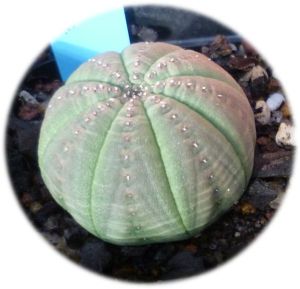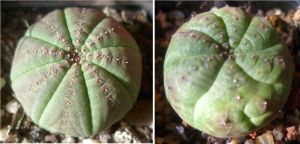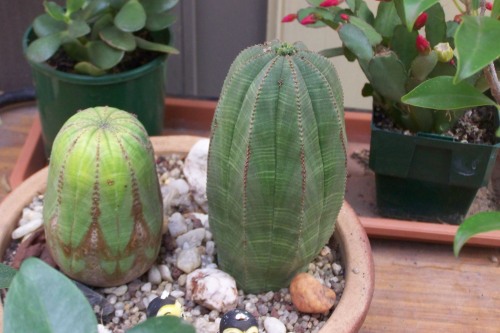
Baseball Plant – Euphorbia obesa
Catatan: Tulisan ini untuk jenis Kaktus yang berasal dari padang pasir dan tanah gersang. Bukan untuk jenis Kaktus hutan tropis yang tumbuhnya menumpang dipepohonan (Epiphytic Cactus).
Tanaman kaktus maunya tidak sering disiram. Sudah berapa jumlah kaktus yang kutanam akhirnya mati karena aku terlalu menyayanginya. Kalau dengan banyak tanaman lainnya, semakin dirawat dan dimanjakan akan semakin subur. Namun kalau kita terlalu sering menyiram kaktus, apalagi kalau tinggal didaerah dingin, tanaman yang berasal dari daerah panas dan gersang itu akan membusuk. Didaerah empat musim, penyiraman harus dihentikan sama sekali selama musim dingin….. ini yang aku tak bisa dengan mudah melakukannya.
Tanaman cactus kalau ditanam didalam pot harus dijaga supaya tidak sering kehujanan, dan selama musim panas/kering hanya disiram kalau tanah sudah mulai mengering. Kaktus didalam pot harus diletakkan ditempat yang terkena sinar matahari dan terbuka tapi terlindung dari curah hujan yang tinggi. Beranda rumah adalah tempat yang ideal untuk menaruh kaktus didalam pot. Didaerah yang curah hujannya rendah, kaktus bisa ditanam ditanah dikebun yang berpasir dan segera menyerap air, terutama jenis kaktus yang tumbuh tinggi dan besar. Kalau ditanam ditanah tak memerlukan pupuk dan tak perlu disiram.

Penis Plant – Trichocereus bridgesii sp
Untuk menanam kaktus didalam pot diperlukan media tanam yang mengandung 40 % pasir dan kerikil. Kerikil bisa diganti dengan bata yang dihancurkan. Disini kami bisa beli tanah siap pakai khusus untuk kaktus. Tapi bisa juga dibuat sendiri dengan mencampur 60 % potting mix biasa dan 20% pasir kasar dan 20 % kerikil. Kalau ditanam ditanah, kaktus tak perlu diberi pupuk. Kalau ditanam dipot hanya memerlukan sedikit (separoh ukuran) pupuk sekali setahun. Kalau tanaman kaktus keluar bunganya bisa dipakai pupuk yang rendah kadar nitrogen-nya. Kalau kaktus tak berkembang, bisa pakai sedikit NPK balanced fertilizer.
Kemarin aku luangkan waktu untuk satu persatu meneliti koleksi tanaman kaktus kami yang masih mampu hidup. Kuperhatikan apakah ada serangga yang bersarang terutama yang mengisap sari makanan dari kaktus tersebut. Kubersihakan sarang laba-laba dan juga potnya yang berdebu. Bekas daun yang mengering pada tanaman Senecio globosa harus dipotong supaya kelihatan rapi. Dari semua kaktus yang kami punya, ada satu yang tidak sehat.
Kaktus ‘Penis Plant’ ( Trichocereus sp. Montrose) kelihatan tidak mulus karena banyak bercak-bercak putih. Memang jenis tanaman ini sering mengalami problema ini, walau biasanya tidak mematikan tapi tidak sedap dipandang. Bercak yang seperti kerak putih itu bisa disebabkan oleh tanah dan udara yang terlalu lembab dan kurangnya sinar matahari dimana bakteri atau jamur menyerang. Namun sebaliknya terlalu banyak sinar matahari yang panas sekali bisa membakar permukaan kaktus yang mulus ini hingga menjadi keriput dan akhirnya juga berubah menjadi kerak putih. Karena yang punya kami letaknya dinaungan beranda, akan kucoba untuk memindahkannya diluar untuk mendapatkan sinar matahari langsung jika temperatur tidak panas sekali. Semoga upaya ini akan bisa mengurangi tumbuhnya kerak-kerak putih tsb.

Senecio globosa and Euphorbia trigona

Euphorbia anoplia and Euphorbia melbraformis

Ferocactus latipinus (Fishhook Barrel) and other Ferocactus sp.
















